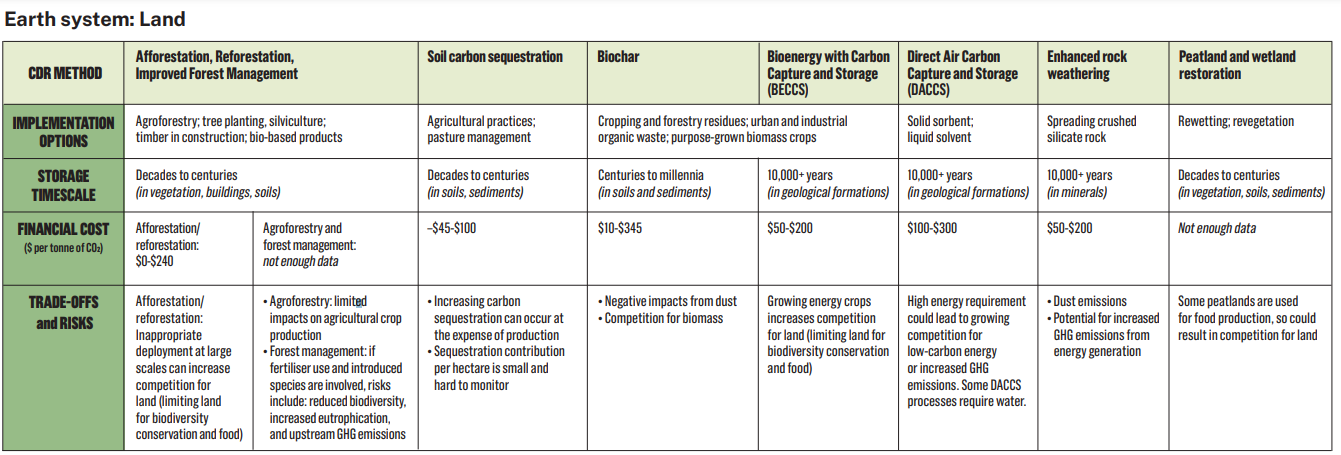Biodiversity & Environment
Balancing Climate Goals and Biodiversity Protection
- 01 Jan 2024
- 5 min read
For Prelims: Balancing Climate Goals and Biodiversity Protection, Carbon Dioxide Removal (CDR) Strategies, Paris Agreement, Climate Change.
For Mains: Balancing Climate Goals and Biodiversity Protection, Environmental pollution and degradation.
Why in News?
Recently, a study has been published titled-Balancing climate goals and biodiversity protection: legal implications of the 30x30 target for land-based carbon removal, highlighting the conflicts between land-based Carbon Dioxide Removal (CDR) Strategies and the establishment of protected areas, focusing on international environmental law.
What are the Key Highlights of the Study?
- Limited Land Availability:
- The Limitations in land availability is a critical challenge in implementing both biodiversity targets and land-based climate mitigation strategies.
- With countries pledging significant portions of land for CDR activities, this poses a challenge to establishing protected areas due to limited available land.
- Global Targets and Current Status:
- Nations have committed to the “30x30” biodiversity target to safeguard 30% of the world’s terrestrial and marine areas by 2030. However, as of 2023, protected areas cover only around 16% of terrestrial areas and 8% of marine areas, falling short of the 30x30 goal.
- The 30×30 target implies protection of at least 30 % of the world’s land and ocean by 2030.
- The 30×30 target is a global target that aims to halt the accelerating loss of species and protect vital ecosystems that are the source of our economic security.
- Nations have committed to the “30x30” biodiversity target to safeguard 30% of the world’s terrestrial and marine areas by 2030. However, as of 2023, protected areas cover only around 16% of terrestrial areas and 8% of marine areas, falling short of the 30x30 goal.
- Land Use and Conflict:
- Certain land-based mitigation strategies conflict with the need to establish more protected areas due to land use constraints.
- Large-scale deployment of CDR could result in further biodiversity loss and competition for land used in food crop production.
- Insufficiency of Targets:
- Despite the ambitious nature of the 30x30 target, researchers estimate that a minimum of 44% of global land should be under protected areas to effectively conserve biodiversity.
- Moreover, CDR activities alone may not fulfill the goals outlined in the Paris Agreement to limit global warming to 1.5 or 2 degrees Celsius.
- Challenges in Implementation:
- Questions arise regarding how countries will allocate additional land for protected areas and restoration while expanding food production and implementing CDR strategies.
- Balancing these objectives poses a significant challenge.
- Legal Perspectives:
- While some land-based CDR approaches could benefit biodiversity, current international environmental law does not prevent the implementation of CDR techniques alongside protected areas on the same land parcels.
- Recommendations:
- There is a need to focus on CDR policies that effectively absorb greenhouse gases while also protecting biodiversity. They emphasize the urgent need to mitigate climate change, stating that the threat it poses to biodiversity far outweighs other concerns.
What is Carbon Dioxide Removal (CDR)?
- About:
- CDR refers to technologies, practices, and approaches that remove and durably store carbon dioxide (CO2) from the atmosphere.
- Methods:
UPSC Civil Services Examination, Previous Year Questions (PYQs)
Q. “Momentum for Change: Climate Neutral Now” is an initiative launched by (2018)
(a) The Intergovernmental Panel on Climate Change
(b) The UNEP Secretariat
(c) The UNFCCC Secretariat
(d) The World Meteorological Organisation
Ans: (c)
- “Momentum for Change: Climate Neutral Now”, is an initiative launched by the UNFCCC secretariat in 2015.
- The initiative is a pillar under Momentum for Change which seeks to achieve climate neutrality.
- Climate neutrality is a three step process, which requires individuals, companies and governments to measure their climate footprint; reduce their emissions as much as possible and offset what they cannot reduce with UN certified emission reductions. Therefore, option (c) is the correct answer.
Q2. In the context of mitigating the impending global warming due to anthropogenic emissions of carbon dioxide, which of the following can be the potential sites for carbon sequestration? (2017)
- Abandoned and uneconomic coal seams
- Depleted oil and gas reservoirs
- Subterranean deep saline formations
Select the correct answer using the code given below:
(a) 1 and 2 only
(b) 3 only
(c) 1 and 3 only
(d) 1, 2 and 3
Ans: (d)






